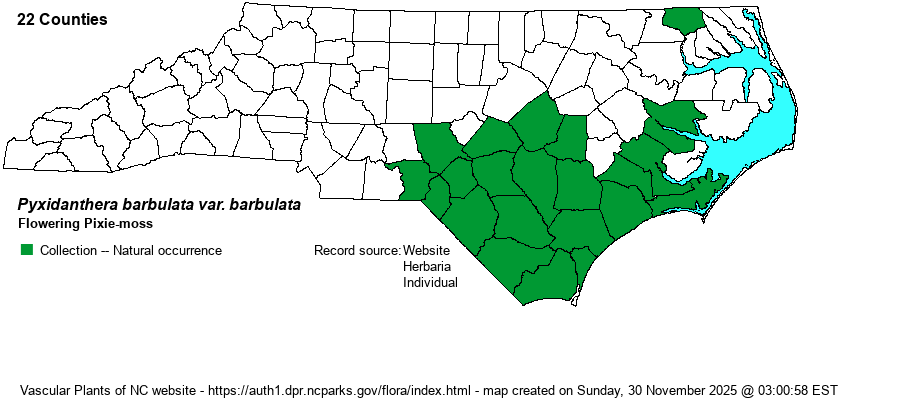| Author | Michaux | |
| Distribution | Occurs only in the Coastal Plain, and essentially limited to the southern and central counties, though disjunct north to Gates County (and adjacent VA). Seemingly absent between Gates County on the north and Beaufort and Johnston counties.
This is a narrow endemic to the eastern-central Atlantic states, ranging north to Long Island (NY) south to only northeastern SC. It is mostly found in NJ and NC; if fact, there are no records yet for MD and DE.
| |
| Abundance | Uncommon to fairly common in the southern half of the Coastal Plain. In the Sandhills, both varieties occur but var. brevifolia is much more common. Occurs in dense “patches” and can be easily overlooked beneath leaves and taller vegetation. Though locally numerous on the Chowan Sand Banks in Gates County, it is extremely rare in the northern Coastal Plain. | |
| Habitat | This is a taxon of rather wet pine flatwoods and margins of pocosins and streamhead pocosin seepages. It may occur in drier pine savannas on the outer Coastal Plain and locally in the Sandhills. It favors damp sandy soil, with little competing vegetation; it may grow with sphagnum moss. | |
| Phenology | Blooms very early, mainly in March and into April; fruits in May and June. | |
| Identification | This is a tiny sub-shrub that is an evergreen species, growing mat-like on the ground in often sizable patches. It has abundant, tiny narrow leaves that are only about 1/5-inch long, very crowded on the several stems. The overall visual aspect is that of a moss instead of a vascular plant, and it can be easily overlooked as a moss, or simply overlooked completely, if it were not for its numerous rather small white flowers. Even though each flower is barely 1/3-inch across, the many flowers on a moss-like plant growing flat on the ground almost give a “snow-like” effect. | |
| Taxonomic Comments | Though we believe that there are 2 distinct entities, brevifolia and barbulata have been treated by others as full species or fully lumped. Weakley (2020) weighs the evidence and treats them as varieties, whereas NatureServe treats them as separate species.
| |
| Other Common Name(s) | Common Pyxie-moss, Big Pyxie | |
| State Rank | S3 [S4] | |
| Global Rank | G4 | |
| State Status | | |
| US Status | | |
| USACE-agcp | | |
| USACE-emp | | |

